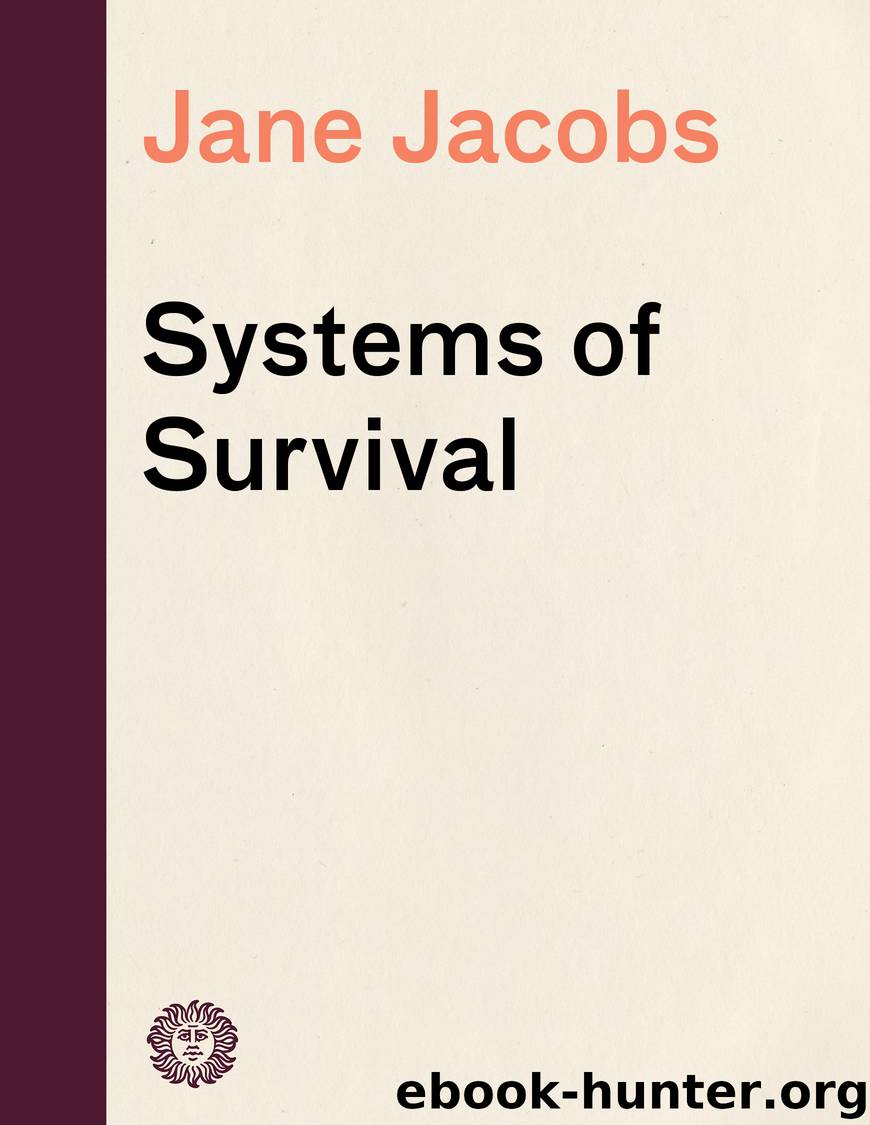Systems of Survival by Jane Jacobs

Author:Jane Jacobs
Language: eng
Format: epub
Publisher: Knopf Doubleday Publishing Group
Published: 2016-08-17T04:00:00+00:00
Casts of Mind
TO ARMBRUSTER’S SURPRISE and gratification, Ben was the first to arrive at the next session, brandishing a printed newsletter as he seated himself. “Wait till Kate hears this,” he said. “She’ll flip.”
“Something to refute her?” asked Armbruster as he started the coffee and set out muffins and fruit.
“No, as a matter of fact, the opposite. From an unexpected source. A good source that I respect.”
As soon as the others arrived, Armbruster gave Ben the floor. “This is a newsletter from an international ecological research organization based in England,” Ben began. “It tells about important insights and breakthroughs made by Dr. Steve Cousins, a researcher on their staff. Wait till you hear! Ecologically speaking, we’re part of the biosphere, like geology and climate.
“To understand this, you need a little background. The definition of an ecosystem says that it is ‘composed of physical-chemical-biological processes active within a space-time unit of any magnitude.’ All serious students of ecology consider that definition basic. But this newsletter points out that ecology still remains more a concept than a solid scientific discipline. So much research leads only into blind alleys. Cousins thinks ‘of any magnitude’ is too vague and that this fuzziness in the definition is a handicap.
“An objective way of delineating concrete ecosystem units and setting boundaries to them is missing. He’s proposed that ecosystem units should be identified by their food webs, sometimes called food chains. However, that’s just another concept unless there’s a technique for identifying them and setting boundaries. So he proposes using the range of a locality’s top predator group, the animal at the top of the local food web. For instance, polar bears’ presence would identify and bound some units. Kodiak bears’ ranges would identify and bound others; timber wolves’ ranges others, and so on.”
“I am not sure I understand this,” said Jasper. “I would think human beings would be the top predator species everywhere. Take those polar bears. Eskimos kill and eat them. Where does that get you? It gets you one single ecosystem unit all the way from the Arctic to the tropics.”
“Wait, there’s more,” said Ben. “When Cousins and his colleagues were first weighing the pros and cons of possible ecosystem unit definitions, before they hit on the food web as key, they puzzled over whether nonbiological factors like climate and geology could be paramount markers: rainfall, sunlight, temperature, wind forces, elevation, that sort of thing. They decided not, on the good grounds that they’re already reflected in the food webs. So those factors were separated out. They’re the biosphere environments in which biological ecosystem units sit.
“That reasoning led Cousins to another big breakthrough. He conceded that isolated human bands using primitive weapons to hunt could qualify as top predators. But he also pointed out that including human beings is unsatisfactory and that this must have been true even in olden times. For instance, ancient peoples came into wooded ecosystems and replaced the forests with field-and-hedgerow agriculture. Nothing else—this is important—except a radical change in climate would convert woodlands to grasslands and shrubs.
Download
This site does not store any files on its server. We only index and link to content provided by other sites. Please contact the content providers to delete copyright contents if any and email us, we'll remove relevant links or contents immediately.
| Anthropology | Archaeology |
| Philosophy | Politics & Government |
| Social Sciences | Sociology |
| Women's Studies |
The Secret History by Donna Tartt(18237)
The Social Justice Warrior Handbook by Lisa De Pasquale(11964)
Thirteen Reasons Why by Jay Asher(8477)
This Is How You Lose Her by Junot Diaz(6463)
Weapons of Math Destruction by Cathy O'Neil(5858)
Zero to One by Peter Thiel(5508)
Beartown by Fredrik Backman(5374)
The Myth of the Strong Leader by Archie Brown(5251)
The Fire Next Time by James Baldwin(5034)
How Democracies Die by Steven Levitsky & Daniel Ziblatt(4972)
Promise Me, Dad by Joe Biden(4916)
Stone's Rules by Roger Stone(4875)
100 Deadly Skills by Clint Emerson(4702)
A Higher Loyalty: Truth, Lies, and Leadership by James Comey(4568)
Rise and Kill First by Ronen Bergman(4554)
Secrecy World by Jake Bernstein(4408)
The David Icke Guide to the Global Conspiracy (and how to end it) by David Icke(4398)
The Farm by Tom Rob Smith(4332)
The Doomsday Machine by Daniel Ellsberg(4254)
